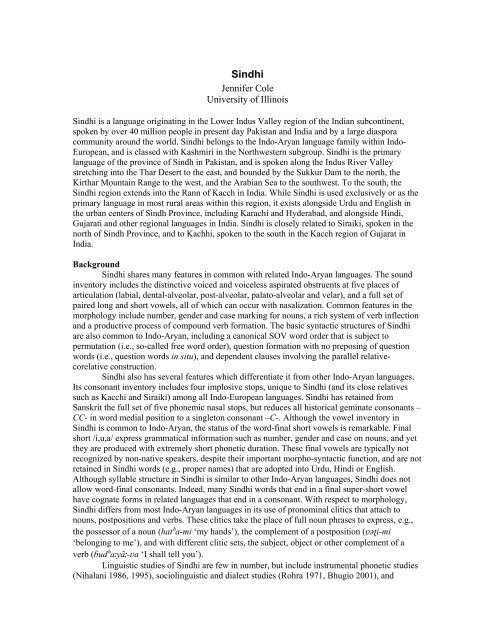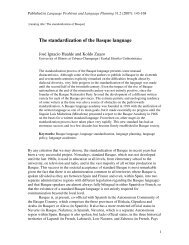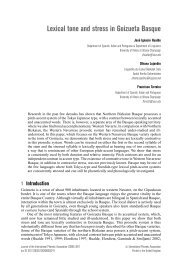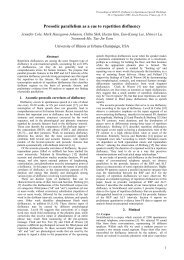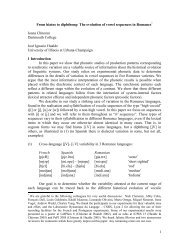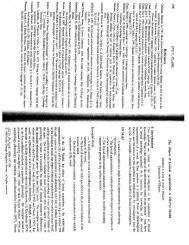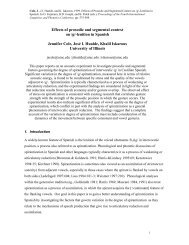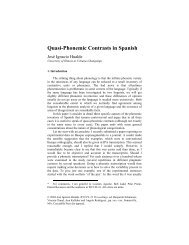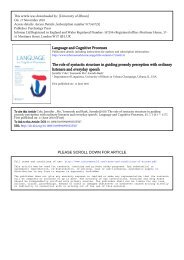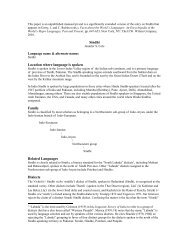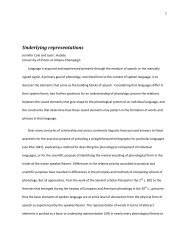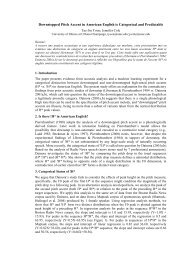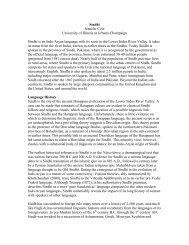Sindhi - Speech Prosody
Sindhi - Speech Prosody
Sindhi - Speech Prosody
Create successful ePaper yourself
Turn your PDF publications into a flip-book with our unique Google optimized e-Paper software.
<strong>Sindhi</strong><br />
Jennifer Cole<br />
University of Illinois<br />
<strong>Sindhi</strong> is a language originating in the Lower Indus Valley region of the Indian subcontinent,<br />
spoken by over 40 million people in present day Pakistan and India and by a large diaspora<br />
community around the world. <strong>Sindhi</strong> belongs to the Indo-Aryan language family within Indo-<br />
European, and is classed with Kashmiri in the Northwestern subgroup. <strong>Sindhi</strong> is the primary<br />
language of the province of Sindh in Pakistan, and is spoken along the Indus River Valley<br />
stretching into the Thar Desert to the east, and bounded by the Sukkur Dam to the north, the<br />
Kirthar Mountain Range to the west, and the Arabian Sea to the southwest. To the south, the<br />
<strong>Sindhi</strong> region extends into the Rann of Kacch in India. While <strong>Sindhi</strong> is used exclusively or as the<br />
primary language in most rural areas within this region, it exists alongside Urdu and English in<br />
the urban centers of Sindh Province, including Karachi and Hyderabad, and alongside Hindi,<br />
Gujarati and other regional languages in India. <strong>Sindhi</strong> is closely related to Siraiki, spoken in the<br />
north of Sindh Province, and to Kachhi, spoken to the south in the Kacch region of Gujarat in<br />
India.<br />
Background<br />
<strong>Sindhi</strong> shares many features in common with related Indo-Aryan languages. The sound<br />
inventory includes the distinctive voiced and voiceless aspirated obstruents at five places of<br />
articulation (labial, dental-alveolar, post-alveolar, palato-alveolar and velar), and a full set of<br />
paired long and short vowels, all of which can occur with nasalization. Common features in the<br />
morphology include number, gender and case marking for nouns, a rich system of verb inflection<br />
and a productive process of compound verb formation. The basic syntactic structures of <strong>Sindhi</strong><br />
are also common to Indo-Aryan, including a canonical SOV word order that is subject to<br />
permutation (i.e., so-called free word order), question formation with no preposing of question<br />
words (i.e., question words in situ), and dependent clauses involving the parallel relativecorelative<br />
construction.<br />
<strong>Sindhi</strong> also has several features which differentiate it from other Indo-Aryan languages.<br />
Its consonant inventory includes four implosive stops, unique to <strong>Sindhi</strong> (and its close relatives<br />
such as Kacchi and Siraiki) among all Indo-European languages. <strong>Sindhi</strong> has retained from<br />
Sanskrit the full set of five phonemic nasal stops, but reduces all historical geminate consonants –<br />
CC- in word medial position to a singleton consonant –C-. Although the vowel inventory in<br />
<strong>Sindhi</strong> is common to Indo-Aryan, the status of the word-final short vowels is remarkable. Final<br />
short /i,u,a/ express grammatical information such as number, gender and case on nouns, and yet<br />
they are produced with extremely short phonetic duration. These final vowels are typically not<br />
recognized by non-native speakers, despite their important morpho-syntactic function, and are not<br />
retained in <strong>Sindhi</strong> words (e.g., proper names) that are adopted into Urdu, Hindi or English.<br />
Although syllable structure in <strong>Sindhi</strong> is similar to other Indo-Aryan languages, <strong>Sindhi</strong> does not<br />
allow word-final consonants. Indeed, many <strong>Sindhi</strong> words that end in a final super-short vowel<br />
have cognate forms in related languages that end in a consonant. With respect to morphology,<br />
<strong>Sindhi</strong> differs from most Indo-Aryan languages in its use of pronominal clitics that attach to<br />
nouns, postpositions and verbs. These clitics take the place of full noun phrases to express, e.g.,<br />
the possessor of a noun (hata-mi ‘my hands’), the complement of a postposition (i-mi<br />
‘belonging to me’), and with different clitic sets, the subject, object or other complement of a<br />
verb (udaya-a ‘I shall tell you’).<br />
Linguistic studies of <strong>Sindhi</strong> are few in number, but include instrumental phonetic studies<br />
(Nihalani 1986, 1995), sociolinguistic and dialect studies (Rohra 1971, Bhugio 2001), and
contemporary grammatical analysis (Khubchandani 1961). Published <strong>Sindhi</strong> grammars include<br />
Trumpp (1872), Grierson (1919) and Yegorova (1971).<br />
Key structural features<br />
Sound inventory. The <strong>Sindhi</strong> sound inventory is shown below, and is notable for its inclusion of<br />
four implosive stops, which derive from Middle Indo-Aryan geminate voiced stops in medial<br />
position, and from singleton voiced stops in initial position. Phonetic studies show that these<br />
sounds are genuine glottalic ingressives (Nihalani 1986). The post-alveolar consonants are apical<br />
and the palato-alveolar consonants are laminal; these are termed retroflex and palatal in<br />
traditional nomenclature. Sounds that are shown in parentheses in the chart below are either<br />
restricted to borrowings (/z, , x, /) or occur only as allophonic variants. For instance, the postalveolar<br />
rhotic tap [] is in complementary distribution with the homorganic stop []. The<br />
aspirated sonorants /m, n, , l ,/ occur only in intervocalic position and are never<br />
distinguished from a sequence of sonorant + /h/, although speakers will describe them as single<br />
sounds, even though they are written as sequences in the Arabic orthography. The vowel<br />
inventory consists of the standard symmetrical Indo-Aryan system, comprising five pairs of long<br />
and short vowels. Phonetic values shown below are as identified by Nihalani (1995). In addition,<br />
all the vowels can occur with nasalization; the long nasal vowels have phonemic status, but<br />
nasalization on short vowels can be ascribed to the context of a following tautosyllabic nasal stop.<br />
<strong>Sindhi</strong> consonant inventory<br />
Labial Dental Alveolar Postalveolaalveolar<br />
Palato-<br />
Velar Glottal<br />
Stop p b t d k <br />
p b t d k <br />
Implosive <br />
Affricate<br />
t t<br />
d d<br />
Nasal m n <br />
(m) (n) ()<br />
Fricative f s (z) () (x ) h<br />
Rhotic<br />
r ()<br />
Lateral<br />
Glide<br />
<br />
()<br />
l<br />
(l)<br />
<br />
y<br />
<strong>Sindhi</strong> vowel inventory<br />
i [i] e [e] a [] o [o] u [u]<br />
i [] e [] a [] o [] u []<br />
Morphophonology. <strong>Sindhi</strong> has a complex system of morhophonological vowel alternations that<br />
affect stem-final vowels in certain morphological constructions. These changes are highly<br />
idiosyncratic to the specific construction. For example, nouns are marked for plural number by
modification of the stem-final thematic vowel alone or in combination with a plural suffix,<br />
resulting in plural endings marked variously by<br />
/-a, -a, -u, -iu/, or unmarked, depending on the gender class of the noun and on its lexically<br />
determined stem-final thematic vowel: ar-a ‘houses’, pit-a ‘wheels’, ka-u<br />
‘cots’, ili-u ‘cats’, rati ‘nights’. There are also very many verb stems that undergo irregular<br />
allomorphy in the formation of the Unspecified Perfective (i.e., simple past) tense.<br />
Comprehensive discussion of these alternations is provided in Trumpp (1872) and Grierson<br />
(1919).<br />
Morphology.<br />
Nouns, adjectives and pronouns. Nouns are classed by grammatical gender, and this<br />
classification determines the declension pattern for the marking of number and case, expressed<br />
primarily through stem vowel alternations. The noun stem ends in a thematic vowel, which for<br />
most nouns serves to mark the gender class, though there are numerous exceptional stems whose<br />
gender is not predictable on the basis of the final vowel. All nouns are marked for number and<br />
case through noun stem modification, involving a change in the thematic vowel, sometimes<br />
accompanied by suffixation. Patterns of noun stem modification that mark the plural and the<br />
nominative, oblique, ablative and vocative cases are illustrated in the example noun paradigms<br />
below for distinct thematic vowels, grouped by gender class.<br />
Masculine: - u ‘flower’ - o ‘boy’ - u ‘resident’<br />
Nom.sg. ulu tokiro rahaku<br />
Nom.pl ula tokira rahaku<br />
Obl.sg. ula tokire rahakua, rahakui<br />
Obl.pl. ulani tokirani rahakuani, rahakuni<br />
Abl.sg. ula tokira rahakua<br />
Abl.pl. ulania tokirania rahakuania<br />
Voc.sg. ula tokira rahaku<br />
Voc.pl. ula tokira rahakua<br />
Feminine: - a ‘table’ - i ‘eye’ - a ‘world’ - i ‘notebook’<br />
Nom.sg. meza aki duniya kapi<br />
Nom.pl mezu aki duniyau kapiu<br />
Obl.sg. meza akiu duniya kapia, kapia<br />
Obl.pl. mezuni akiuni duniyauni kapiuni<br />
Abl.sg. meza akia duniya kapia<br />
Abl.pl. mezunia akiunia duniyaunia kapiunia<br />
Voc.sg. meza aki duniya kapi<br />
Voc.pl. mezu akiu duniyau kapiu<br />
The dative, ablative, comitative and locative cases are marked through the use of a postposition<br />
following the noun in the oblique sg. form. The genitive postposition has eight variants (of which<br />
only two are shown below); it is declined like an adjective and agrees in number and gender with<br />
the possessed noun, but bears the case specification of the possessor. There is no accusative<br />
postposition, and instead the nominative or dative form is used (depending on the animacy of<br />
subject and object). Also, the oblique case forms are also used to mark ergative subjects (see<br />
Syntax section below).
Case/number marking with postpositions in example phrases with gar- ‘house’<br />
Dative gara ke ‘the house (direct object)’<br />
Ablative gara ka ‘from (the direction of) the house’<br />
gara ma<br />
‘from in the house’<br />
gara ta<br />
‘from on the house’<br />
Comitative gara sa ‘with the house’<br />
Locative gara me ‘in the house’<br />
gara te<br />
‘at/on the house’<br />
gara madi ‘within the house’<br />
Genitive<br />
(masc.) gara jo (daru) ‘(door) of the house’<br />
house-masc.,sg.,Obl.|Gen-masc.,sg.,Nom.|door-masc.,sg.,Nom.<br />
(fem.) gara ji (dari) ‘(window) of the house’<br />
house-masc.,sg.,Obl.|Gen-fem.,sg.,Nom.|window-fem.,sg.,Nom.<br />
Adjectives agree with the noun they modify in gender, number and case, marked through the<br />
same kind of alternation of the thematic (final) vowel: nano garu ‘small house, Nom.’ nana<br />
gara ‘small houses, Nom.’, nandi meza ‘small table, Nom.’, nandiyu mezu ‘small tables,<br />
Nom.’. Pronouns are marked for number, but case is marked only for nominative and oblique (no<br />
ablative or vocative pronoun forms). Gender is distinguished only in the nominative, third person<br />
singular forms. The third person pronouns are also used for demonstratives, for which there are<br />
distinct proximal and distal forms: hiu ‘this, masc.’, hu ‘that, masc.’, hia ‘this, fem.’, hua ‘that,<br />
fem.’ The personal pronouns are shown below, including dialectal variants, and similar patterns<br />
of declension occur with the distinct relative and correlative pronouns (jo relative ‘who/thatmasc.,sg.,Nom.’;<br />
so co-relative ‘who/that-masc.,sg.,Nom.’), and the indefinite pronouns (ko<br />
indefinite ‘anyone/someone-masc.,sg.,Nom.’. Of the interrogative pronouns, only ‘who’ is<br />
marked for number and case (e.g., keru ‘masc.,sg.,Nom.’, kah ‘masc./fem.,sg.Obl.’)<br />
Personal pronouns<br />
First person Second person Third person (proximal)<br />
Singular Nom. au, a ; ma, mu tu hi, hiu (masc.);<br />
hi, hia (fem.)<br />
Obl. a, mu, mu ; ma to hina<br />
Gen. a-jo, muhu-jo, mu-jo tuhu-jo, tuh-jo hina-jo<br />
Plural Nom. as tavah, tav, tah ; hi, he<br />
avah<br />
Obl. asa, asah, asahu tavaha, taha ; avaha, hinani<br />
aha<br />
Gen. asa-jo, asah-jo tavha- jo ; avha-jo hinani-jo<br />
Verbs. The verb complex in <strong>Sindhi</strong> consists of a primary verb, alone or followed by an auxiliary<br />
verb. An operator or modal verb element may also occur, placed in between the primary verb (in<br />
participle form) and the auxiliary verb. These parts combine in various ways to produce 17<br />
distinct finite verb forms that encode aspect (perfective, imperfective, unspecified), tense (past,<br />
present, future), mood (subjunctive, imperative, presumptive, counterfactual), and concordance<br />
(gender and number). Aspect is expressed in the choice of the primary verb form, and marked by
suffixation to the verb stem. In most finite verb forms, tense, mood and concordance features are<br />
expressed on the auxiliary verb, through suffixation or auxiliary verb stem allomorphy. There are<br />
also six nonfinite verb forms that function as nominal, adjectival and adverbial participles.<br />
Example finite and non-finite verb forms are shown below. Each finite and non-finite verb form<br />
can undergo further modification, not shown here, to express voice (active/passive) and valence<br />
(transitive/causative) distinctions through the use of suffixes that attach directly to the verb stem.<br />
Examples of finite verb forms with the verb stem hal- ‘to go’<br />
Contingent Future hale ‘if he goes’<br />
Present Unspecified hale to ‘he goes’<br />
Contrafactual Unspecified hale ha ‘had he gone’<br />
Definite Future halando ‘he will go’<br />
Present Habitual halando ahe ‘he goes’<br />
Past Habitual halando huyo ‘he used to go’<br />
Presumptive Imperfective halando hundo ‘he is probably going’<br />
Subjunctive Imperfective halando huje ‘ (perhaps) he goes’<br />
Present Continuous hali rahyo ahe ‘he is going’<br />
Past Continuous hali rahyo huyo ‘he was going’<br />
Unspecified Perfective halyo ‘he went’<br />
Present Perfective halyo ahe ‘he has gone’<br />
Past Perfective halyo huyo ‘he had gone’<br />
Presumptive Perfective halyo hundo ‘he must have gone’<br />
Subjunctive Perfective halyo huje ‘he may have gone’<br />
Past Iterative halyo the ‘he would go’, `he often went’,<br />
‘he used to go’<br />
Imperative<br />
halu<br />
‘Go!’ (rude)<br />
halo, halije<br />
‘Go!’ (polite)<br />
Examples of non-finite verb forms with various stems<br />
Infinitive<br />
halau<br />
aiu<br />
Adjectival Unspecified<br />
(masc.,sg.)<br />
Adjectival Imperfective<br />
(masc.,sg.)<br />
Adjectival Perfective<br />
(masc.,sg.)<br />
Adverbial Imperfective<br />
Adverbial Perfective<br />
mario<br />
waio<br />
halando<br />
marindo<br />
halyalu, halyo<br />
maryalu, maryo<br />
halande<br />
marinde<br />
hali, hali kare<br />
mare, mare kare<br />
‘to go’<br />
‘to sing’<br />
‘about to be struck’<br />
‘about to be taken’<br />
‘going’<br />
‘striking’<br />
‘went’<br />
‘struck’<br />
‘(as he was) going’<br />
‘(as he was) striking’<br />
‘(as he) went’<br />
‘(as he) struck’<br />
Syntax. The neutral word order in <strong>Sindhi</strong> is Subject-Object-Verb, although these elements can be<br />
permuted in any order, in which case the first element is typically the Topic. Within phrases word<br />
order is fixed, with the head element always at the end. Thus, the determiner and adjective<br />
precede the head noun in a noun phrase: hia suhii tokiri this|beautiful|girl ‘this beautiful girl’,
asaja a akra our|two|goats ‘our two goats’. Similarly, the verb appears at the end of the verb<br />
phrase, following any (non-sentential) arguments: ama-ke tii liki mother-to|letter|wrote<br />
‘wrote a letter to mother’.<br />
The subject of the sentence appears in the nominative case with two exceptions:<br />
“experiencer” subjects of verbs expressing physical sensation, psychological state or kinship are<br />
in the dative case, and the ergative subject of a transitive verb in the perfective aspect is in the<br />
oblique case. The verb agrees with the subject if it is nominative, and otherwise agrees with a<br />
nominative (inanimate) object if present. If there is no nominative subject or object, the verb<br />
takes as default the third person, masculine, singular agreement. An indirect object appears with<br />
the dative postposition. There is no distinct accusative case; a direct object appears with the<br />
dative postposition for animate objects, and is in the nominative case for inanimate objects.<br />
Examples of verb agreement with nominative case subjects<br />
hua hale ti<br />
they,fem.,Nom.| go| Aux.,3pl.fem.<br />
‘They (fem.) go.’<br />
hu tii paanda<br />
they,masc.,Nom.| letter,fem.,sg.,.Nom.| will read,3pl.masc.<br />
‘They (masc.) will read the letter.’<br />
Examples of verb agreement in sentences with oblique case ergative and experiencer<br />
subjects<br />
hunani tii pai ahe<br />
they,masc.,Obl.| letter,fem.sg.,Nom.| read,perf.,3sg.,fem.| Aux,3sg.<br />
‘They (masc.) have read the letter (fem.).’<br />
tavaha ke hunani sa aao pavando<br />
you,pl.masc.,Obl.| Dat.| them,pl.,Obl.| with| go,Inf.,Obl.| must,3sg,masc.<br />
‘You (pl.) must go with them.’<br />
Historical development and socio-political factors. Sindh is home to the ancient Indus Valley<br />
civilization of Mohen-jo-daro, but a historical link between <strong>Sindhi</strong> and the language of Mohen-jodaro<br />
has not yet been firmly established. Sindh has been subject to foreign rule at many times in<br />
its history, and there is evidence of language contact in numerous borrowings from Persian,<br />
Arabic and English. The formation of Pakistan in 1947 had a tremendous impact on <strong>Sindhi</strong>, as<br />
millions of mostly Urdu speaking immigrants came to Sindh from India. The immigrants were<br />
under no pressure to learn <strong>Sindhi</strong>, and enjoyed the advantage of speaking Urdu, the language<br />
chosen as the national language of Pakistan. On the other hand, <strong>Sindhi</strong> speakers, especially those<br />
in urban areas, were compelled to learn Urdu, and in recent years, English. Bughio’s (2001)<br />
sociolinguistic study reports census data that paints a bleak picture of the diminishing status of<br />
<strong>Sindhi</strong>. Census data from 1941 show 82% of the Sindh population claim <strong>Sindhi</strong> as their mother<br />
tongue, while in 1981 that number falls to 52%. Sindh has a large rural population, with 57% of<br />
the total population, and in rural areas <strong>Sindhi</strong> is the mother tongue for 78% of the population,<br />
compared to only 18% in urban areas. The rural and urban populations of Sindh differ also in<br />
literacy, with 51% literacy rates in urban areas compared to only 16% in rural areas, of which<br />
female literacy constitutes only 5%. The decline in <strong>Sindhi</strong> literacy has implications for the<br />
survival of the rich body of <strong>Sindhi</strong> literature, dating from the 16 th century (Ajwani 1970).
Selected Bibliography<br />
Ajwani, Lalsingh H. 1970. History of <strong>Sindhi</strong> Literature. New Delhi: Sahitya Akademi (reprinted<br />
1994).<br />
Bughio, Qasim. 2001. A Comparative Sociolinguistic Study of Rural and Urban <strong>Sindhi</strong>.<br />
Muenchen, Germany: Lincom Europa.<br />
Grierson, Sir George A. 1919. Linguistic Survey of India, Vol.VII, Part I: Indo-Aryan Family:<br />
Northwestern Group, Specimens of <strong>Sindhi</strong> and Lahnda. Calcutta: Superintendent Government<br />
Printing.<br />
Khubchandani, Lachman M. 1961. The phonology and morphophonemics of <strong>Sindhi</strong>. Unpublished<br />
University of Pennsylvania M.A. thesis.<br />
Masica, Colin P. 1991. The Indo-Aryan Languages. Cambridge: Cambridge University Press.<br />
Nihalani, Paroo. 1986. Phonetic implementation of implosives. Language and <strong>Speech</strong>, 29:253-62.<br />
Nihalani, Paroo. 1995. <strong>Sindhi</strong>. Journal of the IPA, 25(2):95-98<br />
Rohra, Satish K. 1971. <strong>Sindhi</strong>, Kacchi, and Emigrant <strong>Sindhi</strong>. Indian Linguistics, 32.2: 123-31.<br />
Stack, Captain George. 1849. Dictionary, English and <strong>Sindhi</strong>. Bombay: American Mission Press.<br />
Trumpp, Ernest. 1872. Grammar of the <strong>Sindhi</strong> Language. London: Trubner and Co. and Leipzig:<br />
FA Brockhaus.<br />
Yegorova, R.P. 1971. The <strong>Sindhi</strong> Language. Moscow: “Naukua” Publishing House.


